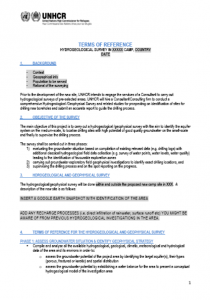
These sample terms of reference may be used should WASH actors working in refugee settings with to engage the services of a Consultant to carry out hydrogeological surveys of pre-selected areas. The terms of reference cover the following areas…
Evaluating the groundwater situation based on compilation of existing relevant data (e.g. drilling logs) with additional classical hydrogeological field data collection (e.g. survey of water points, water levels, water quality) leading to the identification of favourable exploration zones
Carrying out groundwater exploratory field geophysical investigations to identify exact drilling locations, and
Supervising the drilling process and on the spot reporting on the progress.
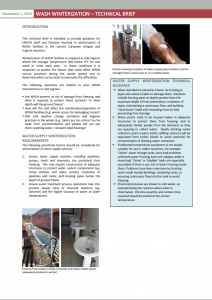
This technical brief is intended to provide guidance for UNHCR staff and Partners involved in winterization of WASH facilities in the current European refugee and migrant situation.
Tags: Bathing Facilities, Cold Climates, Cross Cutting, Excreta Management, Hygiene Promotion, Piped Water Networks, and Water Supply. Locations: Central Europe and the Baltic States, Eastern Europe, and Europe. Languages: English. Organisations: UNHCR. Categories: WASH Emergency Guidelines, WASH Emergency Tools, WASH Guidelines, WASH Operational Guidelines, WASH Policy Guidelines, and WASH Reference Documents.
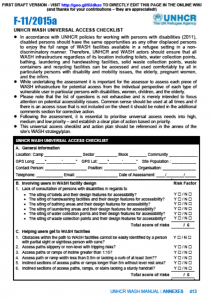
This document has been designed to help UNHCR and WASH actors assess WASH infrastructure for potential access from the individual perspective of each type of vulnerable user in particular persons with disabilities, women, children, and the elderly.
Tags: Bathing Facilities, Communal Toilets, Cross Cutting, Disability, Laundering Facilities, WASH Assessments, WASH Monitoring, WASH Programme Management, WASH Strategy Development, and Water Supply. Languages: English. Organisations: UNHCR. Categories: WASH Blank Forms, WASH Operational Guidelines, WASH Policy Guidelines, and WASH Reference Documents.
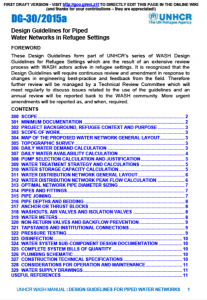
This document contains guidelines to help UNHCR and WASH actors design piped water networks in refugee settings. It describes the minimum documentation that should be included for a water network design project.
Tags: Piped Water Networks, WASH Monitoring, WASH Programme Management, WASH Strategy Development, Water Pumping, Water Storage, and Water Supply. Languages: English. Organisations: UNHCR. Categories: WASH Design Guidelines, WASH Guidelines, WASH Policy Guidelines, WASH Reference Documents, and WASH Technical Designs.
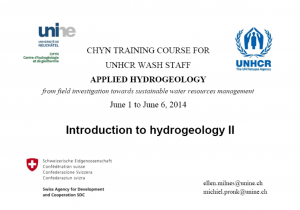
This 289 page document provides and extensive introduction to applied hydrology and includes the following chapters: Introduction to the training course; Introduction to hydrogeology I; Introduction to hydrogeology II; Basic concepts of groundwater exploration; Bacteriological analysis of water; Basic concepts of groundwater protection; Basic concepts of aquifer characterisation: pumping tests; Well construction and rehabilitation
Recharge quantification in semi-arid areas with remote sensing;
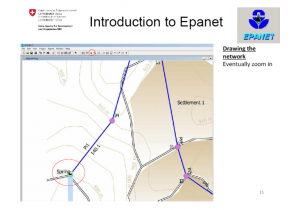
This 161 page document provides a thorough introduction to EPANET (US Environmental Protection Agency) water distribution network modelling software with a focus on designing networks for refugee settings.
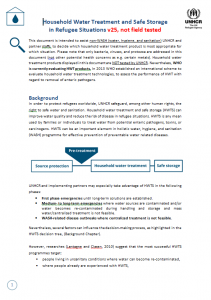
This document contains guidelines to help WASH actors in refugee settings select household water treatment products. The document includes an overview of: • Categories of HWTS; • Health benefits; • When to use HWTS and existing decision tree; • Criteria regarding HWT to be considered by the field; • Mandatory components; • UNHCR Checklist for HWTS; • HWT concerns; • Household water treatment cards; • Safe water storage;• Further reading; • Acknowledgement
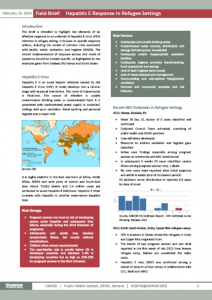
This brief is intended to highlight key elements of an effective response to an outbreak of hepatitis E virus (HEV) infection in refugee setting. It focuses on specific response actions, including the review of common risks associated with health, water, sanitation, and hygiene (WASH). The overall implementation of response actions and mode of operation should be context specific, as highlighted by the examples given from Dadaab (Ifo) Kenya and South Sudan.
Tags: Bulk Water Treatment, Excreta Management, Handwashing with Soap, Household Water Treatment, Hygiene Promotion, Public Health, Water Quality Testing and Surveillance, and Water Safety Plans. Locations: Africa, Dadaab, East and Horn of Africa, Kenya, South Sudan, and Sudan and Chad Special Operational Region. Languages: English. Organisations: UNHCR. Categories: WASH Emergency Guidelines, WASH Guidelines, WASH Operational Guidelines, WASH Policy Guidelines, and WASH Reference Documents.
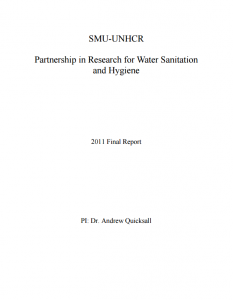
The SMU team conducted five sampling missions to UNHCR refugee camps in Uganda, Kenya, Bangladesh, Djibouti, and Liberia. Overall, these missions were considered a success with 17 camps, 7 villages, and a few additional sites visited. The team collected 213 camp samples and 229 total samples for analyses in the laboratory. Camp conditions and source water characteristics varied widely amongst the five countries but also within the camps themselves.
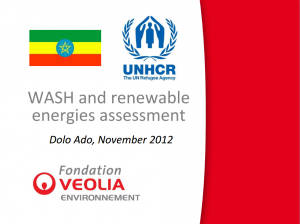
This document looks at drinking water, sanitation and renewable energy solutions and options in three camps in Dolo Odo with recommendations and conclusions.
 English
English










